The apse and the room of the church (A. Ganor et al / the Israel Antiquities Authority) A team of archaeologists from the Israel Antiquities Authority has published a report on results of excavation works conducted in 2010-2011 on the slopes of the Judaean hills at Horbat Midras, including a groundbreaking discovery of a Byzantine-era church.
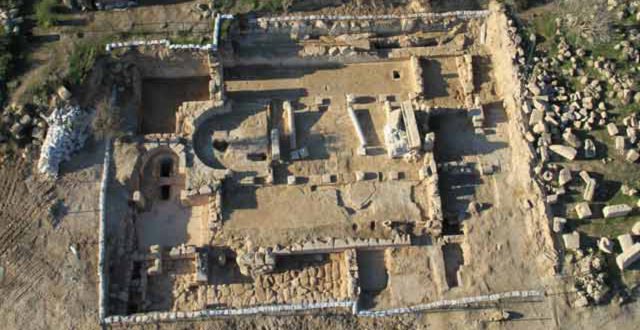 |
| An aerial view of the remains of the Byzantine-era church (A. Ganor et al / the Israel Antiquities Authority) |
Now the team describes their remarkable finds in a report, published in the journal Hadashot Arkheologiyot.
The archaeologists suggest that the site seems to have been occupied from the Persian or Early Hellenistic periods and reached its zenith as a Jewish settlement in the Early and Middle Roman periods (first century BCE – second century CE). The Jewish settlement included buildings, caves, ritual baths, extensive hiding refuges, columbaria, burial complexes and agricultural installations. The finds show that it was destroyed in the Bar Kokhba Revolt.
“The excavation has shown that the site was first inhabited in the Late Second Temple period,” wrote the archaeologists, including directors of the excavations A. Ganor and A. Klein. “This was apparently a Jewish settlement that organized itself before the action of the Roman army to suppress the revolt.”
“Following the destruction of the settlement during the Bar Kokhba Revolt, the place remained deserted until the fourth century CE, when the burial cave was installed at the site, which we think was deliberately left unused.”
Burial cave in an underground cavity (A. Ganor et al / the Israel Antiquities Authority)
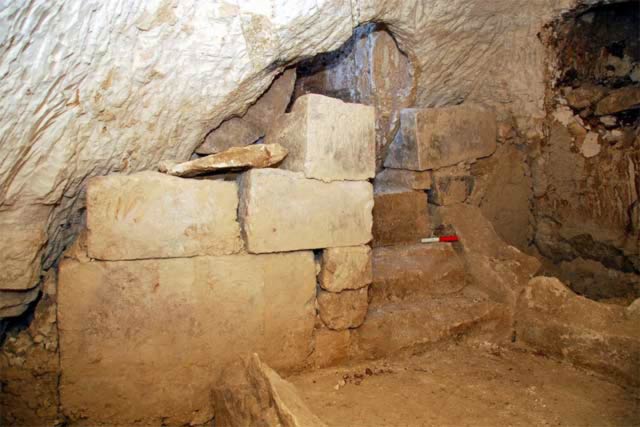 |
| Burial cave in an underground cavity (A. Ganor et al / the Israel Antiquities Authority) |
The team found that the site was re-occupied in the fifth–sixth centuries CE by a small Christian community, that built the church in its northern part and burial complexes decorated with crosses.
“A church was constructed inside the ancient basilica in the sixth century CE,” the team explained. “The expensive building materials of the church, including the marble columns and the floors, show that its construction probably involved a wealthy donor, possibly the Bishop of Eleutheropolis (Bet Guvrin) or possibly some other donor working in cooperation with the bishop.”
“A church built inside the basilica structure utilized part of the latter’s walls and columns. It was entered from the northwest via an atrium and an exo-nathex to very large doorways. The church included a nave (5.3×10.6 m), two aisles, an apse and two L-shaped rooms, adjacent to the apse. The aisles were separated from the nave by two parallel rows of columns, each consisting of four columns. The columns were cut of imported light gray marble and they had identical square bases and Corinthian capitals.”
Mosaic pavement in the southwestern aisle (left) and mosaic in the nave (A. Ganor et al / the Israel Antiquities Authority)
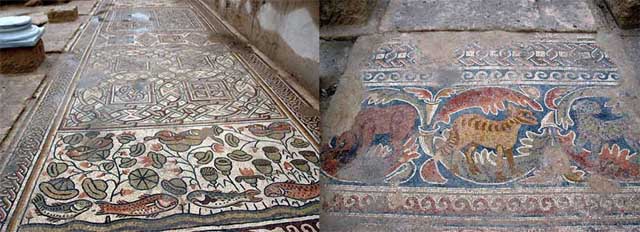 |
| Mosaic pavement in the southwestern aisle (left) and mosaic in the nave (A. Ganor et al / the Israel Antiquities Authority) |
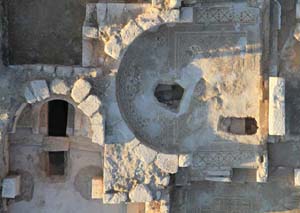 |
| The apse and the room of the church (A. Ganor et al / the Israel Antiquities Authority) |
The team also discovered four massive fallen pillars, which were decorated with a Christogram, consisting of a cross with a loop at its top that together constitute the monogram of the Greek letters chi (X) and rho (P) – the first two letters of the name Christus.
“The church continued to be used after the Muslim conquest,” they wrote. “In a later phase the pillars were covered with a thin layer of white plaster that concealed the crosses. This work was probably done by Muslims who also utilized the church structure.”
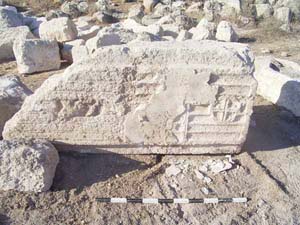
|
| A stone pillar decorated with a cross (A. Ganor et al / the Israel Antiquities Authority) |
This church was destroyed in the earthquake of 749 CE, and small settlement was rebuilt at the site in the Abbasid period (the eighth – ninth century CE).
“It is unclear when and why the site was abandoned,” the team concluded. “During the Mamluk and Ottoman periods, mainly agricultural activity transpired at the site and in the surrounding area.”
